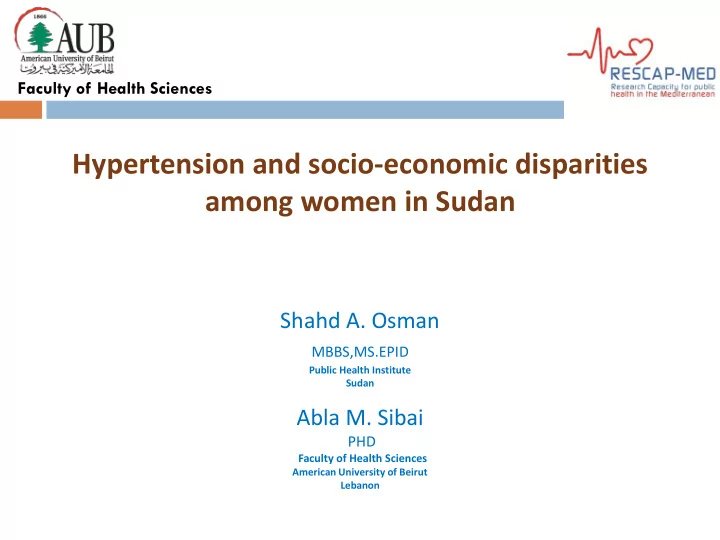

Faculty of Health Sciences Hypertension and socio-economic disparities among women in Sudan Shahd A. Osman MBBS,MS.EPID Public Health Institute Sudan Abla M. Sibai PHD Faculty of Health Sciences American University of Beirut Lebanon
Outline Background Objectives Methodology Results Conclusion and recommendation
Background Non-communicable diseases (NCD) Dominant causes of morbidity and mortality worldwide. Around 63% of deaths are attributed to NCD 80% in low and middle income countries (LMIC) (WHO,2010)
Hypertension 12.8% deaths worldwide 3.7% of DALYs Prevalence in Africa 46% of adults Prevalence in EMR 41% (WHO, 2008)
Prevalence of Hypertension by WHO regions and world bank income groups 2008 (WHO, 2008)
Research Research is mainly from high income countries Research is needed from LMIC • Transition occurring at a faster rate • Political complexity • Economic issues • Infection and NCD • Environmental and geographical factors • What works (Miranda et al,2008) (Ebrahim et al.2013)
Sudan Third largest country in Africa and the sixteenth in the World Connects Arab world with Africa/ Saharan and Sub-Saharan Africa Sudan Overview UNDP
People 37 million Ethnic groups: Sudanese Arab, Fur, Beja ,Falata Young population - 40% below age 15 - 3.3% are 65 and above
History and conflict Independence 1956 North and South 1955-1972/ 1983-2005 • Secession of the South 2011 • Post conflict turbulence in Kordofan and Blue Nile area Darfur 2003, ongoing • Thousands killed, millions displaced
Economy World bank LMIC Agriculture main GDP More than 45% of Sudanese live below the poverty line Huge external debt that consumes more than 60% of Sudan’s GDP Undergoing recession, market inflation up to 45% (World Bank, 2012)
Hypertension in Sudan In Sudan commonest among other NCD (25% of the burden of NCD)- One of the top ten diseases being treated in health facilities (1.3 % of outpatient visits) One of the 10 leading causes of death WHO Stepwise Survey in Khartoum 2005, prevalence of 23.6%, only 11.3% aware. (Annual health statistical report 2008) (WHO stepwise survey 2005)
Objectives To assess the burden of hypertension among adults in Sudan To examine disparities by wealth indices and geographical locations associated with hypertension for the population under study.
Methodology Secondary data analysis: SHHS 2010 Nationally representative carried out by the FMoH and the Central Bureau of Statistics 15,000 households, 14,921 occupied Primary Mandate of the SHHS: Women and Child health and monitor progress toward MDGs
This study excluded men from analysis Low response for men 33% vis-à-vis response of • women (over 92%) The SHHS lacked information regarding pertinent • co-variates (smoking)
Variables and measures • Outcome: hypertension (self reported) • Primary independent variable: SES (Literacy/Education (khlawa); employment and wealth index*) • Secondary independent variable: Geographical location/ Area * The wealth index is a method to divide households into 5 quintiles in terms of “wealth” – from poorest to richest. “Wealth” is constructed by using information on household characteristics (crowding), amenities (water and sanitation), household assets (durable goods) owned by households. (Unicef)
Results Prevalence of Hypertension [VALUE] [VALUE] Yes No
Results Variables Baseline population Prevalence of Hypertension N % n % Total sample 16340 756 4.6 Age 25-34 5818 35.6 33 0.6 35-44 4144 25.4 99 2.4 45-54 3340 20.4 237 7.1 55-64 1622 9.9 193 11.9 ≥65 1388 8.5 194 14.0
Variables Baseline Prevalence of population Hypertension N % n % Level of education No school 9156 56.0 445 4.9 Primary/adult 4636 28.4 222 4.8 learning/khalwa Secondary + 2545 15.6 89 3.5 Employment Not employed 13242 81.0 617 4.7 Employed 3026 18.5 133 4.4
Variables Baseline population Prevalence of Hypertension N % n % Area Rural 10805 66.1 380 3.5 Urban 5535 33.9 376 6.8
Prevalence of Hypertension by Region 1.20% Darfur 3.50% Kurdufan 3.30% Eastern states 4.90% Central states 7.80% Northern states 9.70% Khartoum
Variables Baseline population Prevalence of Hypertension N % n % Wealth index quintiles First 2694 16.5 23 0.9 Second 3522 21.6 66 1.9 Third 3498 21.4 132 3.8 Fourth 3319 20.3 228 6.9 Fifth 3307 20.2 307 9.3
Multivariate analysis, controlling for potential co-varaites Variable (ref.) Adjusted OR 95% CI P-value Area(Rural) Urban 1.20 0.98-1.4 0.081 States(Khartoum) Northern States 0.80 0.6-1.0 0.105 Central States 0.75 0.6-0.97 0.031 Eastern States 0.60 0.4-0.8 0.000 Kordofan region 0.84 0.6-1.2 0.312 Darfur region 0.30 0.2-0.5 0.000
Adjusted Variable (ref.) 95% CI P-value OR Level of education (No school) Primary/adult education/khalwa 1.30 1.1-1.6 0.007 ≥ Secondary 1.31 0.9-1.7 0.117 Wealth index quintiles (First) Second 1.82 1.1-2.9 0.018 Third 3.20 2.0-5.2 0.000 Fourth 5.53 3.4-8.8 0.000 Fifth 6.96 4.3-11.3 0.000
Limitations and Strengths Limitations • Missing information on confounders • Underestimate of hypertension prevalence • Likelihood of differential information bias Strengths • National representative survey • Can serve as a guide for policy makers
SHHS 2014 What about the NCD module? Double burden?
Recommendations Introducing surveillance, monitoring and evaluation programs to the NCD department in the Federal Ministry of Health; along with the other WHO recommended units. Strengthening the Health Information System to serve as a reliable and efficient database on NCD Integrating NCD in the primary health care level to monitor a larger number of the population, on risk factors and burden of disease. The role of WHO-EMRO
Thank you Khartoum, Sudan
Recommend
More recommend